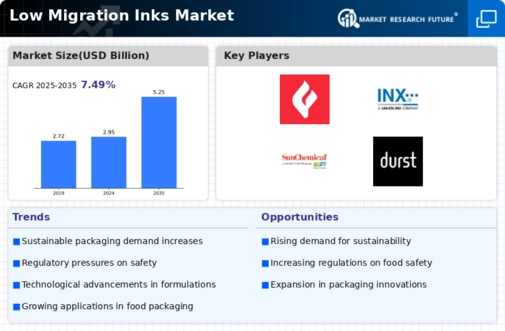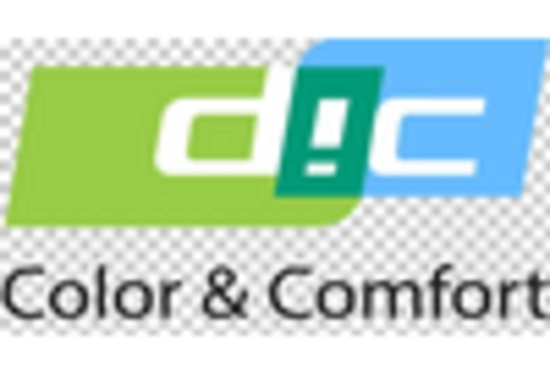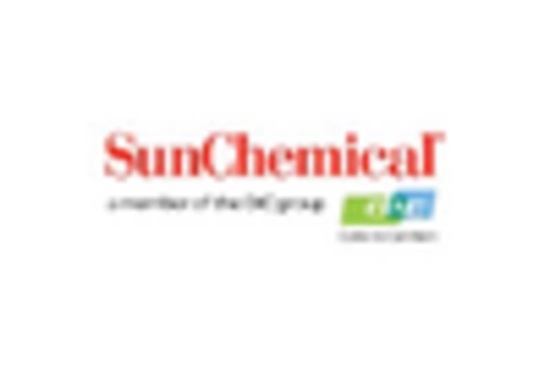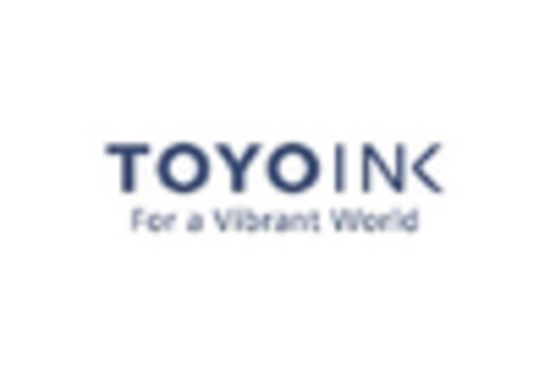Market Analysis
Low Migration Inks Market (Global, 2024)
Introduction
The Low-Migratory Inks Market is a report which focuses on the low-migration inks and is a result of the growing demand for safe and sustainable packaging solutions. The need for inks which minimize the chances of chemical migration into products has increased in the food and beverage, pharmaceuticals, and cosmetics industries. This market is characterized by the innovations in formulations and application techniques which enable manufacturers to meet stringent regulatory requirements while maintaining high-quality print performance. The growing awareness about the environment has also driven the demand for low-migration inks, which use eco-friendly materials and processes. The Low-Migration Inks Market is expected to see significant advancements in technology and a shift in consumer preferences.
PESTLE Analysis
- Political
- In 2024, the low migration inks market is influenced by the strict regulations imposed by governments to protect the health and safety of consumers. In Europe, for example, the migration of substances from packaging materials into food products is regulated, with specific thresholds set at 10 ppb for certain chemicals. This regulatory environment is driving manufacturers to adopt low migration inks that meet these standards, thus increasing the demand for these products in the market.
- Economic
- In 2024, the low migration ink market is characterized by rising raw material costs, which have risen by about 15% in the past year due to supply disruptions and inflationary pressures. The packaging industry, the main consumer of low-migration inks, is expected to be worth about 500 billion by 2024, which will lead to a strong demand for sustainable and compliant packaging solutions. Against this background, manufacturers are forced to constantly innovate and optimize their production processes in order to maintain their profitability.
- Social
- A study shows that 78% of consumers are concerned about the safety of the material used in food containers. The heightened awareness of consumers has led to a growing demand for low migration inks. They want a product that transfers as few chemicals as possible from the packaging to the food. Furthermore, the growing trend towards sustainable and eco-friendly products has an effect on purchasing decisions. A study shows that 65% of consumers are willing to pay a higher price for packaging that is certified as safe and environmentally friendly.
- Technological
- In 2024, the production of low-migration inks is a key technological development, along with digital printing. This year the use of digital printing is to increase by twenty per cent. It allows a more precise application of inks and reduces waste. In the same way, the manufacturers are investing in the development of new formulations for low-migration inks, with improved adhesion and drying time. This is putting pressure on the market.
- Legal
- The regulations concerning the use of inks in the food-packaging industry are becoming increasingly stringent. In 2024 the U.S. Food and Drug Administration (FDA) published new guidelines requiring that all inks used in contact with food be subjected to a rigorous testing program to ensure that they do not exceed the migration limits for certain hazardous substances. These regulations are important for manufacturers, since a failure to comply with them can lead to heavy fines and the recall of products, thereby affecting market conditions.
- Environmental
- In 2024, low migration inks will be shaped by an increasing emphasis on sustainability. About 40 percent of ink manufacturers are already investing in greener formulations that use more renewable resources and fewer volatile organic compounds (VOCs). The worldwide drive to reduce plastic waste is also driving a demand for inks compatible with biodegradable and recyclability. This fits in with the broader goals of reducing the carbon footprint and promoting the circular economy.
Porter's Five Forces
- Threat of New Entrants
- Barriers to entry are medium in the low-migration inks market due to the need for specialized knowledge and technology in ink formulation. The market is growing, but the established companies have a strong brand loyalty and distribution network that can hinder new entrants. However, technological developments and growing demand for low-migration inks could encourage new competition.
- Bargaining Power of Suppliers
- Low - The suppliers in the low migration ink market have limited bargaining power, as there are many suppliers of raw materials. The suppliers of key components have limited influence on the suppliers. The manufacturers can also change the suppliers without much cost, so the power of the suppliers is low.
- Bargaining Power of Buyers
- The buyers in this market, especially the large food and packaging industries, have considerable bargaining power because of their size and the amount of their purchases. They can thus negotiate favourable prices and terms, especially since they are constantly trying to reduce costs. Moreover, they have the power to change suppliers if their requirements are not met.
- Threat of Substitutes
- “There are other printing solutions available, such as regular inks and other printing processes. But the specific benefits of low-migration inks, especially in the case of food packages, make the threat of substitution less likely. However, as technology evolves, new substitutes may be introduced, which could pose a threat to market share.
- Competitive Rivalry
- Low-Migration Inks Market is characterized by intense competition among established players who are constantly innovating to improve product quality and meet regulatory standards. The presence of several key players vying for market share has led to the adoption of aggressive marketing strategies and price wars, thereby escalating the intensity of the rivalry.
SWOT Analysis
Strengths
- High demand for food-safe printing solutions due to increasing consumer awareness.
- Technological advancements leading to improved ink formulations and performance.
- Strong regulatory support promoting the use of low migration inks in packaging.
Weaknesses
- Higher production costs compared to traditional inks, impacting pricing strategies.
- Limited availability of raw materials required for low migration ink production.
- Potential performance limitations in certain applications compared to conventional inks.
Opportunities
- Growing market for sustainable and eco-friendly packaging solutions.
- Expansion into emerging markets with increasing packaging needs.
- Collaborations with packaging manufacturers to innovate and enhance product offerings.
Threats
- Intense competition from established ink manufacturers and new entrants.
- Economic fluctuations affecting the overall packaging industry.
- Regulatory changes that may impose additional compliance costs.
Summary
The Low-Migration Inks Market in 2024 will be driven by strong demand, primarily owing to rising safety concerns and regulatory support, accompanied by technological developments. However, the market is expected to face challenges, such as high production costs and limited availability of raw materials. Opportunities exist in sustainable packaging and in emerging markets. However, competition and economic uncertainties are expected to pose a threat to the market. Strategic alliances and innovations will be important for companies to navigate these dynamics.









Leave a Comment